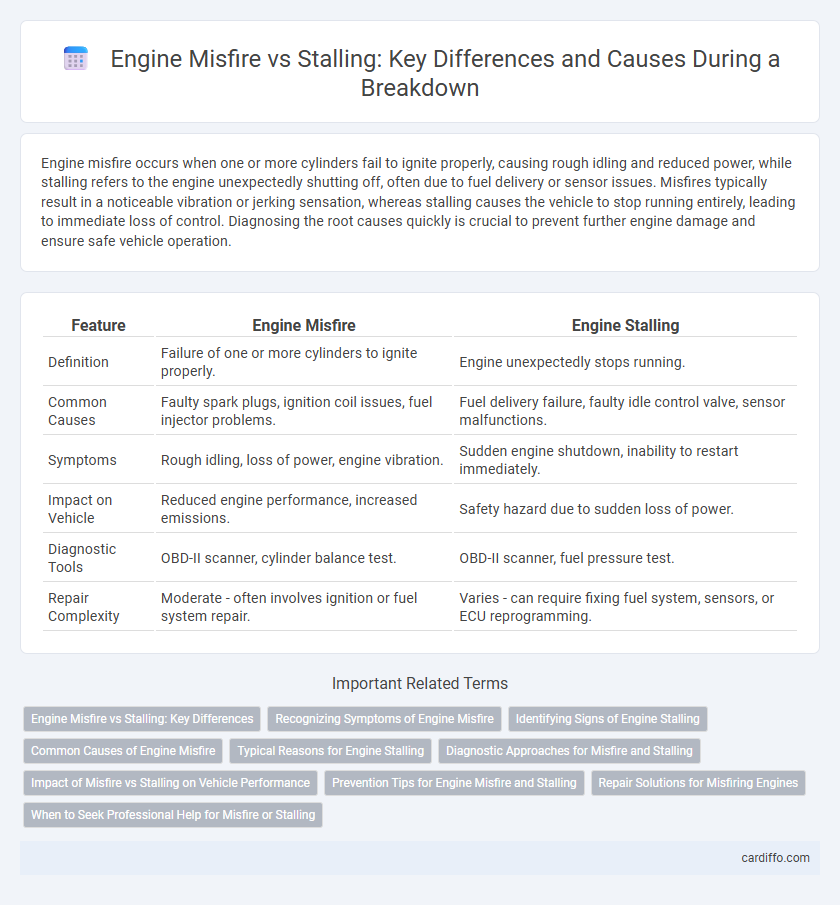Engine misfire occurs when one or more cylinders fail to ignite properly, causing rough idling and reduced power, while stalling refers to the engine unexpectedly shutting off, often due to fuel delivery or sensor issues. Misfires typically result in a noticeable vibration or jerking sensation, whereas stalling causes the vehicle to stop running entirely, leading to immediate loss of control. Diagnosing the root causes quickly is crucial to prevent further engine damage and ensure safe vehicle operation.
Table of Comparison
| Feature | Engine Misfire | Engine Stalling |
|---|---|---|
| Definition | Failure of one or more cylinders to ignite properly. | Engine unexpectedly stops running. |
| Common Causes | Faulty spark plugs, ignition coil issues, fuel injector problems. | Fuel delivery failure, faulty idle control valve, sensor malfunctions. |
| Symptoms | Rough idling, loss of power, engine vibration. | Sudden engine shutdown, inability to restart immediately. |
| Impact on Vehicle | Reduced engine performance, increased emissions. | Safety hazard due to sudden loss of power. |
| Diagnostic Tools | OBD-II scanner, cylinder balance test. | OBD-II scanner, fuel pressure test. |
| Repair Complexity | Moderate - often involves ignition or fuel system repair. | Varies - can require fixing fuel system, sensors, or ECU reprogramming. |
Engine Misfire vs Stalling: Key Differences
Engine misfire occurs when one or more cylinders fail to ignite fuel properly, causing rough idling, loss of power, and increased emissions. Stalling happens when the engine abruptly stops running, often due to fuel delivery issues, sensor malfunctions, or electrical faults, leading to a complete halt in vehicle operation. Understanding the distinct symptoms and causes of engine misfire versus stalling is crucial for accurate diagnosis and effective repair.
Recognizing Symptoms of Engine Misfire
Engine misfire symptoms include rough idling, hesitation during acceleration, and a noticeable drop in power output. Frequent misfires often trigger the check engine light and produce audible backfiring or coughing sounds from the exhaust. Identifying these signs promptly helps differentiate a misfire from stalling, which typically involves the engine shutting down completely without hesitation.
Identifying Signs of Engine Stalling
Engine stalling often presents symptoms such as sudden loss of power, engine shutdown at low speeds, and difficulty restarting, distinguishing it from engine misfire, which involves irregular engine firing and rough idling. Key indicators of stalling include the engine cutting out during acceleration or when coming to a stop, accompanied by dashboard warning lights such as the check engine light. Recognizing these signs promptly is crucial for diagnosing issues like fuel delivery failure, faulty ignition systems, or air intake problems that frequently cause engine stalling.
Common Causes of Engine Misfire
Engine misfire often results from faulty spark plugs, clogged fuel injectors, or ignition system failures, leading to incomplete combustion in one or more cylinders. Stalling, on the other hand, frequently arises from issues like a failing idle air control valve or fuel delivery problems but is less directly linked to combustion faults. Identifying spark plug wear, ignition coil damage, and fuel system blockages remains crucial for diagnosing and resolving engine misfires effectively.
Typical Reasons for Engine Stalling
Engine stalling typically occurs due to fuel delivery issues such as a clogged fuel filter or a failing fuel pump, which disrupt the engine's ability to maintain combustion. Ignition system problems, including faulty spark plugs or ignition coils, also commonly cause the engine to stop running unexpectedly. Additionally, sensor malfunctions like a defective crankshaft position sensor can lead to engine stalling by failing to provide essential data for proper engine timing.
Diagnostic Approaches for Misfire and Stalling
Engine misfire diagnostics involve analyzing ignition system components such as spark plugs, ignition coils, and fuel injectors using an OBD-II scanner to retrieve specific trouble codes. Stalling diagnosis requires checking fuel delivery systems, including the fuel pump, fuel filter, and idle air control valve, alongside inspecting vacuum leaks and sensor signals from the mass airflow sensor and throttle position sensor. Both issues benefit from real-time engine performance data and thorough visual inspections to identify intermittent faults or sensor irregularities.
Impact of Misfire vs Stalling on Vehicle Performance
Engine misfire causes rough idling, reduced power, and increased fuel consumption, significantly impairing acceleration and engine efficiency. Stalling results in sudden engine shutdown, leading to loss of power and control, which poses safety risks especially during traffic or intersections. Both issues degrade vehicle performance, but misfire primarily affects engine smoothness and emissions, while stalling directly impacts drivability and safety.
Prevention Tips for Engine Misfire and Stalling
Regular maintenance such as timely spark plug replacement, fuel system cleaning, and air filter inspection significantly reduces the risk of engine misfire and stalling. Monitoring engine sensors and addressing issues like faulty ignition coils or clogged fuel injectors help maintain smooth engine performance. Using high-quality fuel and avoiding harsh driving conditions also prevents common causes of misfire and stalling, enhancing vehicle reliability.
Repair Solutions for Misfiring Engines
Engine misfire repair solutions involve diagnosing faulty spark plugs, ignition coils, or fuel injectors to restore proper combustion. Replacing worn components and cleaning fuel systems can prevent misfires and improve engine performance. Regular maintenance such as tune-ups and using high-quality fuel are essential for long-term misfire prevention.
When to Seek Professional Help for Misfire or Stalling
Engine misfire and stalling symptoms often indicate underlying issues that require immediate professional diagnosis, especially if the problem persists beyond initial troubleshooting. Seek expert help if the engine repeatedly misfires, stalls during acceleration, or triggers the check engine light, as these signs can point to severe ignition system failures or fuel delivery problems. Prompt intervention by a qualified mechanic prevents further damage to components such as spark plugs, fuel injectors, or the catalytic converter, ensuring vehicle safety and performance.
Engine misfire vs stalling Infographic

 cardiffo.com
cardiffo.com